(group discussions)
latest update 28 November 2009
HGU-2/P, early HGU-2A/P, middle HGU-2A/P, late HGU-2A/P, HGU-22/P, HGU-26/P, Quarter Helmet Assembly
The identification of HGU-2 and -26 series of helmets has been a challenge to many
collectors and for very good reasons too. And then there is the HGU-22/P which causes even
more confusion. Let it be said once and for all; THERE IS NO
SUCH THING AS AN HGU-22/P HELMET. It is a helmet shell, not a complete
helmet.
The change from HGU-2/P to HGU-2A/P is fairly well defined but the HGU-2A/P has changed
its appearance over the years without changing its designation. Usually the HGU-2A/P is a
single visor helmet but HGU-2A/Ps were also modified with ramshorn dual visor assemblies
without changing designation. The HGU-26/P is not clearly defined in official literature
but is most commonly seen as a helmet based on the HGU-22/P helmet shell fitted with the
PRU-36/P side-actuated dual visor. To make things even more confusing, the USAF did away
with the HGU-2A/P designation in the mid-1970s, ending up with single visor and dual visor
versions of the HGU-26/P. This guide is intended to clarify the picture a bit. If nothing
else it will allow you to be confused at a higher level.
HGU-2/P
The HGU-2/P and APH-5 were based on the same helmet with the USAF standardizing theirs as
the HGU-2/P, the US Navy and US Army had the APH-5 and APH-5A respectively. Just
like the US Navy the USAF considered more than one design for replacing the
trusty P-helmet series that had served the USAAF and USAF well from 1948
onwards. General Textile Mills appears to have offered a version designated
DH-5, very much like the DH-5-3 offered to the US Navy, but in the end the USAF
chose the same basic MSA design as the US Navy.
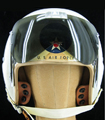
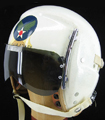
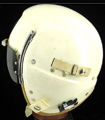
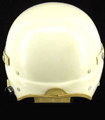
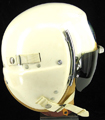
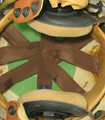
The Navy began
their development around 1956 and the USAF assigned the HGU-2/P nomenclature to their
version on 15 August 1957 and it was produced in accordance with the military
specification MIL-H-26671 dated ???. The HGU-2/P helmet seems to have been fielded from
1959 and differed from the US Navy APH-5 in a few areas. The communications and the oxygen
mask tabs are different and so is the colour of the neoprene edgeroll. Identifying
features of the HGU-2/P helmet are a heavy helmet shell, often with a poorly painted
finish (applies especially to helmets manufactured by Consolidated Components Corp.),
thick grey or tan neoprene edgeroll, visor housing with metal strip reinforcement along
the visor lock knob track, metal visor tracks, and a three-piece styrene energy absorbing
liner. The HGU-2/P is equipped with an H-149/AIC
headset identifiable by the MX-2088/U earcups, the double nylon string attachment and the
microphone plug hanging loosely from the side of the helmet. Original HGU-2/P helmets came
with leather oxygen mask attachment tabs in tan leather with three snaps on each (early
USN APH-5 helmets had black tabs with only two snaps on each). Later HGU-2/P helmets were
often field modified with Hardman receivers for christmas tree bayonets or cast aluminium
receivers for single bayonets. Some were also modified with the three ventilation holes in
the crown, often seen as an identifying hallmark of early HGU-2A/P helmet.
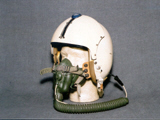
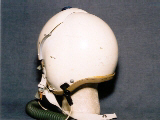
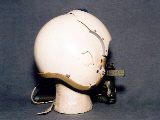
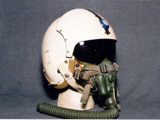
Corporation in December 1960. The oxygen mask communications configuration is not correct. It should have had an early CX-4707/AIC Y-cord ending in a U-93A/U plug at the hose end. This particular helmet was acquired by the Royal Danish Air Force for test purposes which is why it does not have the usual USAF decal on the visor housing.
Pictures © Bluelight
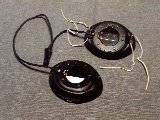
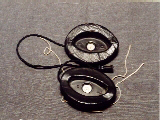
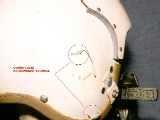
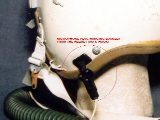
H-149/AIC headset as used in HGU-2/P helmets. It consists of H-143/AIC receivers, MX-2088/U earpads, attachment
rings and a communication cord. The headset is fixed to the helmet shell with nylon strings at the top and bottom of
the metal attachment ring. The nylon strings are visible on the outside of the helmet shell. Note the hanging micro-phone plug in the picture far right. The headset is adjusted to the user by putting a number of foam rubber pads between the earphones and the helmet shell. Pictures © Bluelight
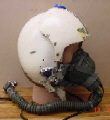
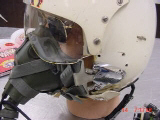
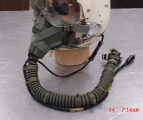
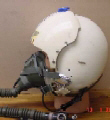
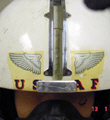
HGU-2/P modified with Hardman receivers and christmas tree bayonets. As can be seen from the pattern of holes in the second picture from the left this helmet has had cast aluminium oxygen mask receivers at an earlier stage. Pictures © Milehigh
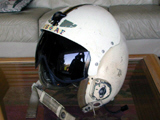
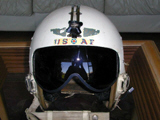
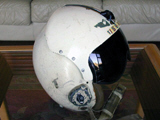
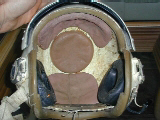
HGU-2/P modified with cast aluminium oxygen mask receivers. HGU-2/P helmets were seen both with this white type of receivers and the black self-adjusting cast receivers. The black visor lock knob is not original but a later retrofit. Pictures © kd6hlr
HGU-2/P Strategic Air Command
Apparently the Strategic Air Command (SAC) intended to use the HGU-2/P helmet
without visor as a successor to the MB-4 helmet. The helmets were produced without the
standard holes for the visor housing and three snaps were added to the brow area to allow
the fitting of a bill like the one used on the HGU-9/P. This is documented by period
photographs and a few surviving helmets but more detailed information has so far to be
discovered.
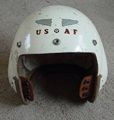
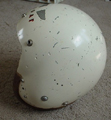
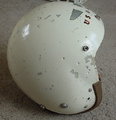
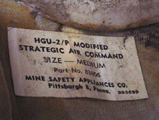
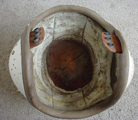
HGU-2/P modified for use in Strategic Air Command. It has the same three snaps over the face opening as other SAC
helmets from the same general period like the HGU-9/P This helmet is not complete. It is missing fitting pads and communications. Pictures © Figmo
HGU-2A/P (early version)
1961-1966
The HGU-2A/P was issued around 1961 as an improved version of the HGU-2/P. The HGU-2A/P
nomenclature (USAF way of indicating an upgrade to the HGU-2/P is with the "A")
was assigned 2 Nov 1960 as the result of design changes documented by both SAC (Form 81 16
Nov 1959) and TAC (Form 81 28 Oct 1959). The first HGU-2A/P military specification
MIL-H-26671A was issued 16 March 1961 allowing production to begin. Just like its US Navy
ancestor, the APH-5, the HGU-2/P was too heavy and suffered from heat build-up problems.
The HGU-2A/P contains improved fitting pads that make the helmet more stable and an
adjustable nape strap. The shell has three ventilation holes in the crown under the visor
housing. The early and middle HGU-2A/Ps are the only models that came with such holes from
the factory but it is a T.O. approved modification used both on HGU-2/P helmets and on
later HGU-2A/P and HGU-26/P helmets based on the HGU-22/P shell. The helmet shell is
reduced in weight when compared with the HGU-2/P and has an improved finish, especially
when compared with HGU-2/P helmets made by Consolidated Controls. The early HGU-2A/P
introduced a new type of headset, the H-154/AIC.
It is easily identifiable with its spring-loaded metal mounting arms. The visor housing
had air louvres at the rear edge to allow the windblast to escape more easily during an
ejection. The reinforcing strips along the visor lock knob track were changed from metal
to plastic.
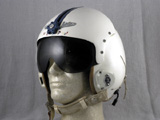
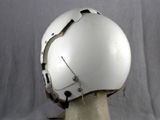
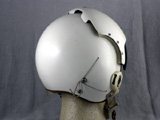
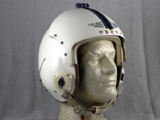
Early HGU-2A/P made by Sierra Engineering Co. in
November 1962. Note the blue plastic strips along the visor lock
knob track and the visor cover with louvres at the rear edge. Pictures © Bluelight
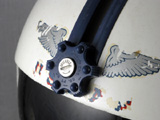
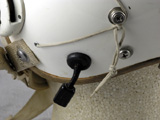
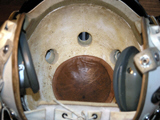
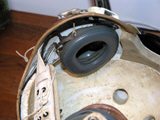
Far left: The six-lobe lock knob made exclusively by Sierra Engineering
Co. Middle left: The microphone plug is
not fixed with an S-hook as seen on later helmets. This was specific to Sierra helmets.
The S-hook was used on
Gentex helmets. Middle right: Early HGU-2A/P helmets have three
factory-made ventilation holes in the helmet
shell under the visor housing. Far right: The H-154/AIC headset is
mounted on spring-loaded metal arms that are
fixed to the helmets shell using the same screws that hold the headset drawstring studs on
the outside of the helmet.
Pictures © Bluelight
HGU-2A/P (middle
version) 1966-1969
The HGU-2A/P military specification was updated to become MIL-H-26671B on 1 December 1966.
The specification is not too specific (no pun intended) on what changes were made from the
original 1961 spec but photo evidence shows that at least the visor housing was changed.
The old glassfibre housing was replaced by a new lighter plastic housing with integral
reinforcing ridges along the visor lock knob track. The lock knob itself was standardised
to become a white four-lobe knob with a square cross section. This helmet version was
produced by at least three companies, Gentex, Sierra Engineering Corp., and Land Mfg. Co.
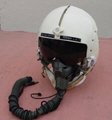
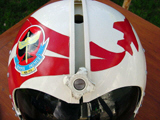
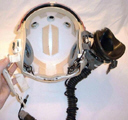
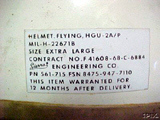
The HGU-2A/P (middle version) can be identified by its
plastic visor housing with the square four-lobe
visor lock knob, the original HGU-2A/P helmet shell with the three cooling holes, and the
H-154/AIC
headset with its spring-loaded metal arms. The best way to identify it is, however, the
label with its
reference to MIL-H-26671B. The picture to the far right shows a label with a spelling
error (22671B
vice 26671B). The pictures show four different helmets. All pictures are © unknown.
HGU-2A/P with ramshorn double visors
Both Sierra and Gentex introduced double visor assemblies for the HGU-2A/P
helmets in the 1960s. Due to their construction they are colloqually known as ramshorns
visors, a term that was actually coined by the inventor of the concept, Sierra Engineering
(see the ad below). Sierra's visor housing was made in one piece while Gentex' housing
consisted of a separate centre visor cover and two visor housing extensions for the visor
lock knobs and actuating rods. Consequently the two visor types are referred to as
one-piece and three-piece ramshorns visors respectively. The two visor types were never
adopted as military standard by USAF and therefore did not get any military designation or
stock numbers. They were. however, used in quite large numbers by USAF aircrew. Modifying an HGU-2A/P helmet with a ramshorn visor did not change the
helmet's designation either. It was still an HGU-2A/P. The visors were, however, mentioned
in the USAF Technical Orders as being commercially available.





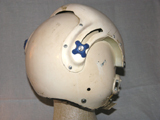
Three pictures to the left: HGU-2A/P helmet
with Gentex' three-piece ramshorn visor. © Cretanman. Middle
right: Ad for Sierra's one-piece ramshorns visor. Right and far right:
HGU-2A/P helmet with Sierra's one-piece
ramshorns visor. © Cretanman and Bluelight
HGU-22/P
The HGU-22/P is not a helmet, it is a helmet shell. HGU-22/P "Helmet shell,
Flying" type designation was assigned 26 April 68 and the military specification
MIL-H-83147 was issued 24 June 1968. The first Qualified Production List (QPL-83147) was
issued 19 March 1969 identifying Gentex and Sierra as the only two manufacturers at that
time. According to the MIL-H-83147 the HGU-22/P
consists of a helmet shell, an polystyrene energy absorbing liner, front edge pad (brow
pad), edge beading, chin strap and nape strap. It was not intended as a helmet in its own
right. It was to be employed as the basic unit to which other essential components and
accessory items (e.g. visor and communications) could be installed by the users to obtain
the required final helmet configuration.
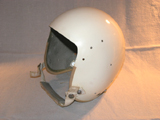
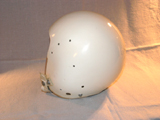
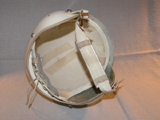
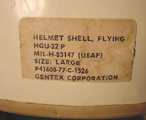
This is what you would get if you ordered an HGU-22/P helmet
shell from Gentex. No visor, no communications
and no oxygen mask retention hardware. One thing is missing from this particular HGU-22/P
- the brow pad
which is supposed to sit above the face opening and hold the styrene liner in position. ©
Bluelight
HGU-2A/P (late version)
1969-1974?
After the introduction of the HGU-22/P helmet shell the HGU-2A/P nomenclature was used to
signify a helmet based on the HGU-22/P shell fitted with a single visor and an H-154A/AIC headset. There is no military
specification covering this configuration; reference is just made to the HGU-22/P specs.
It is unclear when the HGU-2A/P designation disappeared but it may have been already in
1974. MIL-H-26671B was cancelled in 1974 without a superceding document and Gentex sold
single visor HGU-26/P helmets already from that year.
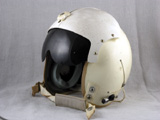
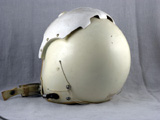
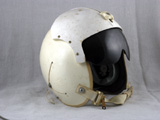
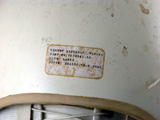
A late version HGU-2A/P ordered in 1973. This
particular helmet is not the most beautiful I have ever seen. It was
stored for at least 30 years in a basement without ever being issued as evidenced by the
missing oxygen mask
receivers. The foam in earphones and fitting pads is heavily deteriorated. © Bluelight
HGU-26/P double visor
The HGU-26/P request for nomenclature is dated Jan 14, 1970 and is based on the HGU-22/P
Helmet Shell. There is no military specification detailing exactly what goes into an
HGU-26/P but until the appearance of the single visor HGU-26/P both USAF and manufacturer
information was consistent in describing the HGU-26/P as an HGU-22/P helmet shell with a
PRU-36/P side-actuated double visor.
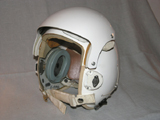
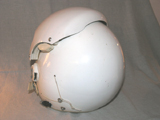
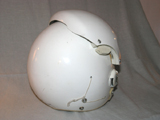
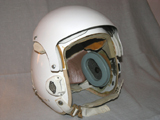
HGU-26/P with PRU-36/P double visor assembly, thin edge
beading and fitting pads. This is the standard configu-ration that usually comes to mind when people talk about HGU-26/P helmets. © Bluelight
HGU-26/P single visor
There are strong indications that both Sierra and Gentex sold single visor HGU-26/P
helmets from late 1974. Gentex' 1974 catalogue has no HGU-2A/P but shows single visor and
double visor versions of the HGU-26/P, and Sierra delivered single visor HGU-26/P helmets
in January 1975 based on a 1974-dated order as witnessed by the pictures below. Single
visor helmets based on the HGU-22/P shell and manufactured after late 1974 are therefore
single visor HGU-26/P helmets, not HGU-2A/P.
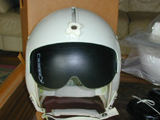
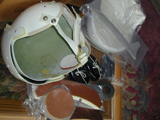
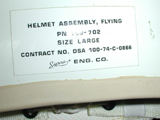
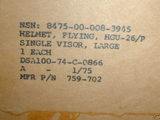
Single visor HGU-26/P manufactured by Sierra
according to a DSA order placed in 1974. Together with other
evidence it strongly suggests that the HGU-2A/P designation disappeared around that time.
© kd6hlr.
Quarter Helmet
Assembly
In the late 1970s it had become commonplace to use custom fit liners. Most customers had
no use for the styrene energy absorbing liner. As a consequence Gentex and Scott started
to field the so-called Quarter Helmet Assembly. It is comprised of a bare HGU-22/P helmet
shell with chin and nape straps and either single or dual visor assembly completely
installed. The customers would then install liners, oxygen mask receivers and
communications to suit their needs. The earliest order I have observed for a Quarter
Helmet Assembly was placed in 1978.
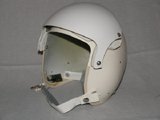
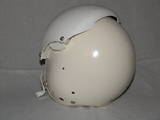
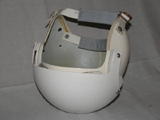
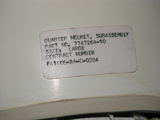
This is not an HGU-26/P helmet even if eBay sellers and
second hand dealers would like us to think so. It could,
however, become one. The pictures show a quarter helmet assembly fresh out of the
manufacturer's cardboard
box. It is just an empty helmet shell with chin and nape straps and a PRU-36/P double
visor housing. This will only
become an HGU-26/P helmet if a liner and an H-154A/AIC headset are added. © Bluelight.
Custom fit helmets and other
'anomalies'
The HGU-2/P, HGU-2A/P and HGU-26/P helmets have been modified and upgraded to meet every
user's whims over the years. The most common modifications are custom fit liners instead
of the standard fitting pads and the single visor cover gullwing cut to improve the
pilot's upward visibility. Both these features are included in the helmet prepared by
Protection Inc. for the USAF Thunderbirds display team. A modification that is less known
is the cut-back of the PRU-36/P visor cover to provide the same improvement in upward
visibility as the gullwing cut on the single visor housing.
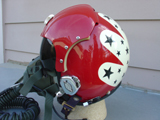
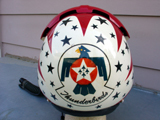
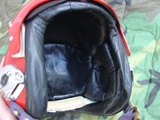
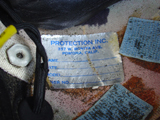
HGU-2A/P custom fit and painted by Protection Inc for the
USAF aerobatic team Thunderbirds. As can be seen from
Protection Inc.'s label on the right this helmet IS an HGU-2A/P and NOT an HGU-33/P as
claimed by so many over
the years. HGU-33/P is a US Navy helmet and the USAF's finest just do not use Navy
helmets. Pictures © maty
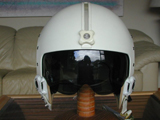
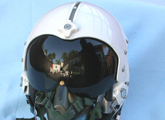
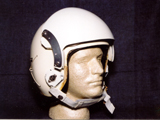
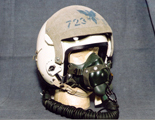
Far left and left: A standard single visor
housing and a visor housing modified with the so-called gullwing cut. The
gullwing profile appears because the central visor lock knob track does not allow a
straight cut across the face opening.
Pictures © kd6hlr and unknown. Right and far right: A standard PRU-36/P
visor housing and a visor housing cut back
to allow improved upwards visibility. This modification is also authorised. Pictures ©
Bluelight